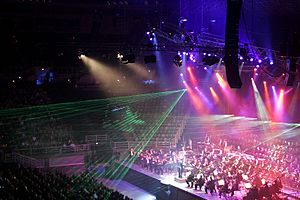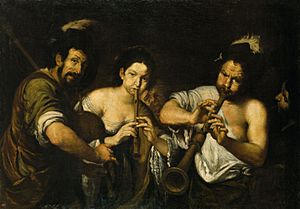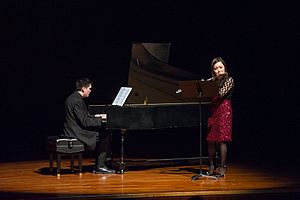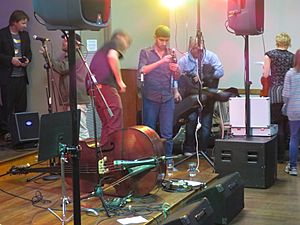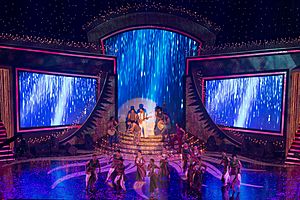Concert facts for kids
A concert is a live music performance where musicians play in front of an audience. It can be a single musician, which is sometimes called a recital, or a group like an orchestra, choir, or band. Concerts happen in many different places, from small nightclubs and houses to large concert halls, arenas, parks, and even sports stadiums. Big indoor concerts are sometimes called arena concerts. Other common names for a concert are show or gig.
No matter where they are held, musicians usually perform on a stage. Concerts often use special sound and light equipment to make the show great. Before music could be recorded, concerts were the main way people could hear musicians play live.
Contents
The History of Concerts
Concerts as we know them today didn't officially start until the late 1600s. However, similar musical gatherings happened earlier in the 17th century at universities like Oxford and Cambridge in England.
The very first public concerts where people had to pay to get in were started by an English violinist named John Banister. Over the next few centuries, concerts became more and more popular, especially classical symphonies. After World War 2, concerts changed into the modern events we see today. An early example of a post-WW2 concert was the Moondog Coronation Ball.
Concerts in the 17th Century
The first concerts that charged admission took place at violinist John Banister's home in Whitefriars, London in 1672. Six years later, in 1678, a man named Thomas Britton held weekly concerts in Clerkenwell. His concerts were different because instead of paying each time, people bought a yearly pass. For 10 shillings a year (which was a lot of money back then), people could attend as many concerts as they wanted.
Concerts also started to reach more people. In 17th century France, concerts were often held in the homes of rich families, just for them. But the first public concerts in France, and possibly the world, were the Concerts Spirituels. These were organized by Anne Danican Philidor. They happened on religious holidays when the Opera house was closed, and they became a model for concert groups all over the world.
Concerts in the 18th Century
In the late 1700s, music by famous composers like Haydn and Mozart was performed at English concerts. One famous work by Haydn played at these concerts was his set of 12 symphonies, known as the London Symphonies.
Elegant concerts were also held in beautiful gardens like Vauxhall, Ranelagh, and Marylebone. The music played at these events included pieces by young Mozart and popular songs of the time.
Different Types of Concerts
The style of a concert changes a lot depending on the musical genre, the performers, and the place it's held. A small jazz group or a bluegrass band might have a similar setup, but their music and how they dress will be very different. Also, the type of music or band often attracts fans who dress and act in similar ways. For example, concert-goers in the 1960s often had long hair and wore simple clothes.
Recital Concerts
A recital is a concert usually given by a single performer or a small group, following a specific program. It can focus on one musician, sometimes with a piano player, or on the music of just one composer, or even just one instrument (like an organ recital). The idea of a solo piano recital is often credited to Franz Liszt. Recitals can also involve many people, like a dance recital, which is a show of choreographed dance moves for an audience. Some dance recitals happen every season.
Theatrical Concerts
Some performers create very detailed and expensive shows. To make the atmosphere exciting and spectacular, they often add extra entertainment. This can include fancy stage lighting, big screens showing electronic images or pre-recorded videos, inflatable sets, artwork, special effects like theatrical smoke and fog and pyrotechnics (fireworks), and unusual costumes.
Some singers, especially in popular music, might use pre-recorded music, back-up dancers, or even pre-recorded parts of their own singing voice to enhance the show. Activities during these concerts can include dancing and sing-alongs. Performers known for these kinds of elaborate shows include: Pink Floyd, The Flaming Lips, Cher, Prince, Alice Cooper, Iron Maiden, Daft Punk, Lady Gaga, Jean Michel Jarre, Sarah Brightman, KISS, Gwar, Rammstein, Slipknot, and Madonna.
Classical Concerts
Classical concerts feature two main styles of classical music: orchestral and choral. They are performed by many different groups in concert halls or other performing arts venues.
For orchestral music, depending on the number of performers and instruments, concerts can be chamber music, chamber orchestra, or symphony orchestra. A chamber orchestra is a smaller group, with ten to forty musicians, mostly playing string instruments, usually led by a conductor. A symphony orchestra, on the other hand, is a large group that can have eighty or more musicians. It's also led by a conductor and includes strings, woodwinds, brass instruments, and percussion instruments.
For choral music, concerts include choral music, Opera, and musical theater. These involve various singers organized by a conductor or director.
Concert Venues
There are many different places where concerts are held, varying in size, location, and the type of music they host.
A concert hall is a venue mainly for classical music, like a symphony. They are often part of a larger performing arts center. One of the most famous concert halls is the Royal Albert Hall in the United Kingdom. This venue hosts many types of music, from classical to pop.
An amphitheater is an outdoor, circular or oval-shaped venue with rows of seats around the stage. Amphitheaters like the famous Red Rocks Amphitheatre in Colorado often host rock and pop concerts. However, rock and pop concerts are mostly held in sports stadiums and arenas, such as Madison Square Garden, because these places can hold a much larger audience.
Concert Formats
Music Festivals
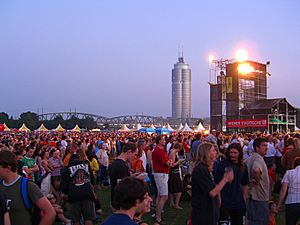
Concerts that involve many artists, especially those lasting several days, are called festivals. Unlike regular concerts that usually focus on one type of music or artist, festivals often feature a wide range of music and arts. Because they are so big, festivals are almost always held outdoors. New types of festivals are becoming popular, like Jam Cruise, which is a festival on a cruise ship, and Mayan Holidaze, a festival held in Tulum, Mexico.
The top ten largest music festivals worldwide are:
- Donauinselfest, Austria
- Mawazine, Morocco
- Summerfest, United States
- Pol'and'Rock Festival, Poland
- Rock in Rio, Brazil
- Coachella Valley Music and Arts Festival, United States
- Sziget Festival, Hungary
- Essence Music Festival, United States
- New Orleans Jazz & Heritage Festival, United States
- Electric Daisy Carnival, United States
Concert Tours
A concert tour is when an artist or group performs a series of concerts in different cities, countries, or locations. Tours are often given names to tell them apart and to link them to a specific album or project (for example, Ariana Grande: Dangerous Woman Tour). Especially in popular music, these tours can be huge events that last for months or even years, are seen by millions of people, and earn a lot of money from ticket sales.
Concert Residencies
A concert residency, or musical residency, is a series of live music concerts similar to a concert tour, but they are all performed at just one location.
Money and Attendance
While some concerts are free, it's common to charge money by selling tickets. Before recorded music became popular and musicians earned money from royalties (payments for their music being played), concerts were the main way musicians made a living. Money from ticket sales usually goes to the artists, people who organize the show, the venue, and ticket sellers. For benefit concerts, part of the money often goes to a charitable organization.
Concerts also make money from advertising. This can range from local businesses sponsoring free local concerts to big companies sponsoring major tours. For example, the "Vans' Warped Tour Presented by AT&T" in 2009 meant that both Vans and AT&T paid a lot of money to have their names featured in all the marketing for the Warped Tour.
Food, drinks, and merchandise (like T-shirts or CDs) are also often sold during and after concerts. The venue usually sells the food and drinks, while the band or artist sells their merchandise.
As of 2017, Italian singer Vasco Rossi holds the record for the biggest attendance at a ticketed concert. He sold 220,000 tickets for his show at Enzo Ferrari Park in Modena, Italy, on July 1, 2017. Before him, Paul McCartney held the record with 185,000 paying fans at his 1990 concert in Maracanã Stadium, Rio de Janeiro. Rod Stewart holds the record for the biggest attendance at a free concert, with an estimated 3.5 million people at his 1994 New Year's Eve concert on Copacabana Beach, Rio de Janeiro.
Images for kids
-
A big band concert in Lappeenranta, Finland
-
Jay Pritzker Pavilion is a bandshell in Chicago's Millennium Park
-
Vasco Rossi's 2017 show at Enzo Ferrari Park, Modena, Italy, set a new world record
See also
 In Spanish: Concierto para niños
In Spanish: Concierto para niños


